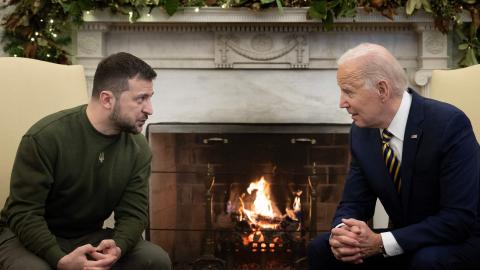During his address to a joint session of Congress in December, Ukrainian President Volodymyr Zelensky summed up US support the best: “Your money is not charity.”
Arming Ukraine to defeat Russia is in America’s interest. Regrettably, President Biden fails to explain why this is the case in a way that resonates with many Americans. Instead of explaining US support for Ukraine using hardheaded geopolitical logic, Biden prefers using the vague notions of defending “a rules-based order” as part of a “great battle of freedom.” While these normative and value-based reasons apply to Ukraine, phrases such as these mean little, if anything, to most American taxpayers.
Russia’s aggression against Ukraine is unprecedented in the twenty-first century. I have visited the site of mass graves in Bucha. I have walked through the destroyed apartment blocks in Irpin. The extrajudicial killing of civilians, the forced deportations of children, and the deliberate targeting of civilian infrastructure amounts to attempted genocide of the Ukrainian people. While the war might be literally a “great battle of freedom” against good and evil, framing the justification for US support in this way does not show the full picture.
It would serve the White House well to start narrowly focusing its rationale for supporting Ukraine to specific U.S. national interests in an era of great power competition.
First and foremost are the economic benefits to the American worker of helping Ukraine defend itself. Vladimir Putin is trying to undermine the stability in Europe that has allowed for the economic prosperity that benefits the US. The broader transatlantic region accounts for approximately 45 percent of the global economy. Combined, the US and Europe accounted for 50 percent of global personal consumption, compared to a combined share of only 14 percent for China and India. The US and Europe were each other’s largest export markets. Forty-five of the 50 states—including the largest Pacific state, California — export more to Europe than to China. This matters to the American heartland, too. If you are reading this article from Arkansas, Kentucky or Oklahoma, your state exports five times more to Europe than it does to China.
American exports to Europe mean millions of American jobs. European stability, which Russia now threatens, brings untold benefits to the US economy and, by extension, to the American worker. If Russia’s invasion of Ukraine spreads to other parts of the continent, the conflict will have unforeseen implications for the US economy.
The second reason why a Ukrainian victory matters for the US is China. Russia and China are intimately connected. Russia is China’s junior partner on the global stage. Many of Russia’s and China’s strategic goals overlap. Both want a weakened and divided Europe that they can exploit. Both want to weaken the transatlantic alliance.
Therefore, what happens in Ukraine impacts what happens in the Indo-Pacific. If Russia is defeated or weakened in Ukraine, China becomes indirectly weaker. Beijing is also watching the Western response to Russia’s invasion closely. This could influence—for better or for worse—Beijing’s decision-making regarding Taiwan. A strong and victorious Ukraine makes Taiwan stronger.
While there might not be direct Chinese material support for Russia’s invasion of Ukraine, it would be naive in the extreme to think that the two countries do not have some sort of security accommodation in place. A sizable amount of Russia’s forces involved with the invasion came from its Eastern Military District. This has left the number of Russian troops on or near the country’s border with China at an unprecedented low level. It’s safe to assume that Putin would not have taken such a step without assurances from Beijing that Russia’s territorial integrity would be respected.
Ukraine is dismantling the conventional armed forces of the Russian Federation at a rate that many assumed to be unthinkable, and at a financial cost that many assumed was impossible. According to open-source reporting based on visual evidence, more than 8,700 major pieces of Russian military equipment — including 1,630 main battle tanks, 1,935 infantry fighting vehicles, 68 aircraft, 75 helicopters and 12 naval ships—have been taken off the battlefield. Considering that these Russian losses are the ones that have been documented with visual proof, the true number likely is far greater.
The US has provided $27.5 billion in military assistance to Ukraine since Russia’s invasion. This equals 3.2 percent of the fiscal year 2023 defense budget, about one-tenth of 1 percent of America’s GDP, or about $3.50 from each American taxpayer per week. For this meager investment, and without a single drop of American blood, the American taxpayer has funded the degradation of the armed forces of one of America’s top geopolitical adversaries.
To keep up congressional and public support for America’s long-term assistance to Ukraine, Biden must start making the case to the American people framed around US national interests. There is a once-in-a-lifetime opportunity to put Russia back into its geopolitical box. It would be a tragedy if this opportunity were squandered because of a White House public relations problem.















